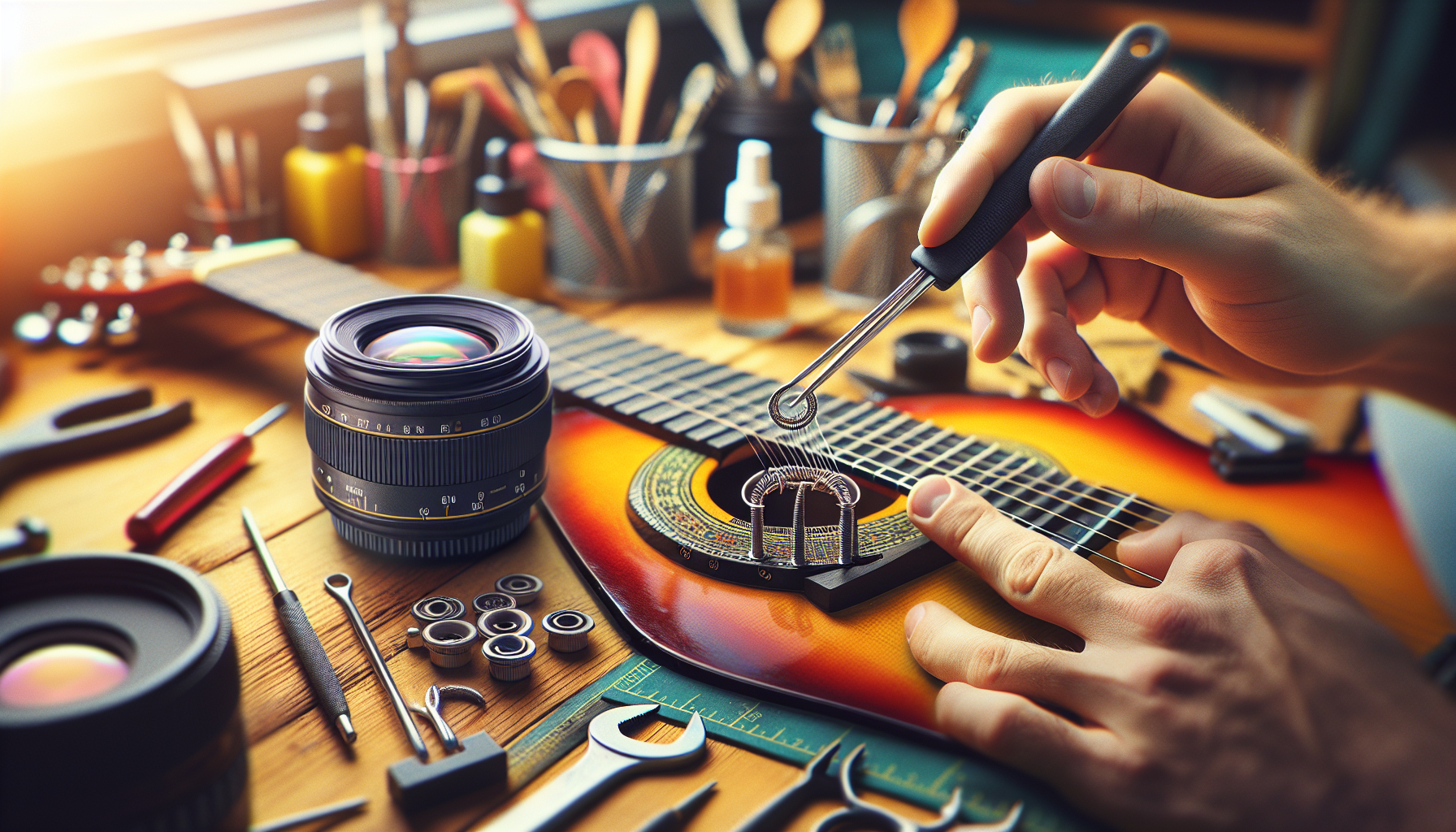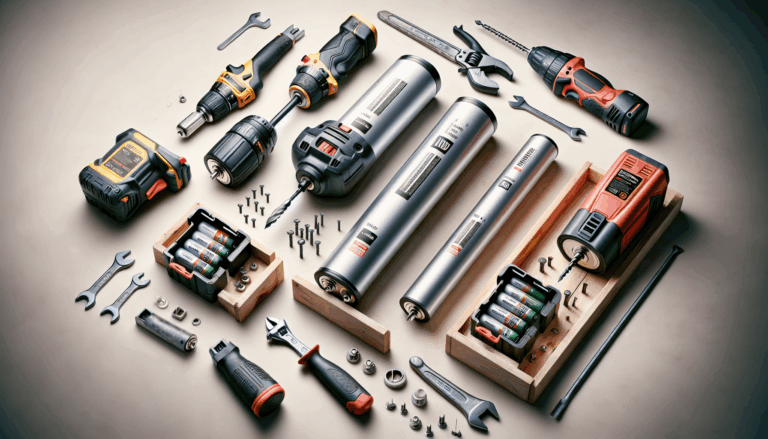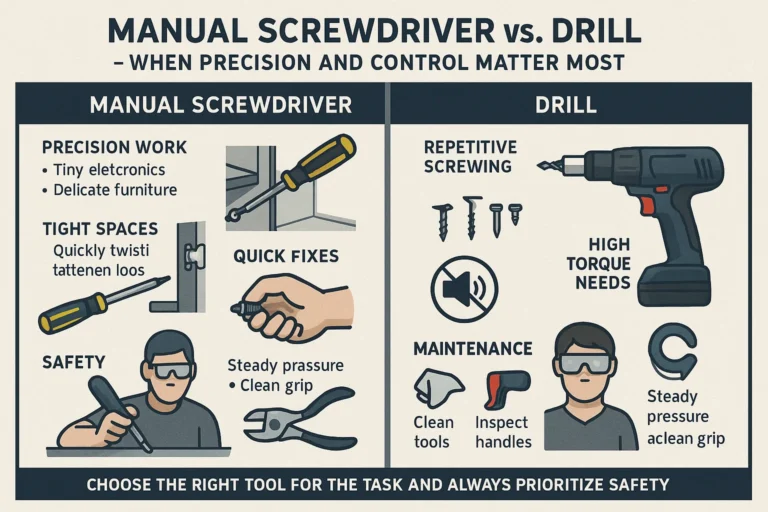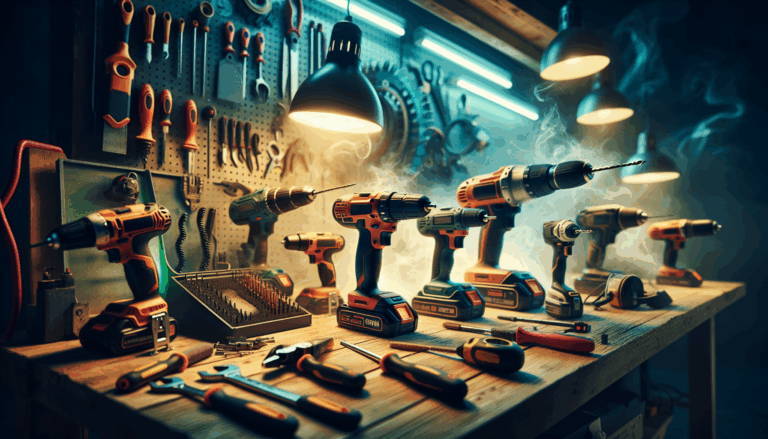What are the essential tools for maintaining a guitar?

String Winder
Changing guitar strings can often be a tedious task, especially for those who are not experienced. A string winder offers a quick and effortless solution, significantly reducing the time it takes to replace strings compared to manual winding. The primary advantage of using a string winder is its ability to rapidly rewind strings with minimal effort, making it particularly beneficial for musicians who frequently change their strings.
When selecting a string winder, consider features such as ergonomic design for comfortable use, compatibility with various guitar types, and durability of materials. Some models even come with built-in cutters or bridge pin pullers, providing all-in-one functionality that enhances convenience. According to Guitar World, using a string winder can decrease the string change time by over 50%, allowing guitarists to spend more time playing and less time maintaining their instrument.
Overall, investing in a quality string winder not only simplifies the process but also improves the performance of your guitar by ensuring that strings are installed correctly and easily.
String Cutter
To cut guitar strings safely without damaging your instrument, utilizing a dedicated string cutter specifically designed for this purpose is crucial. Here are some essential tips for achieving a clean cut:
- Choose the Right Tool: Opt for a high-quality string cutter. These tools generally have precision blades, ensuring clean cuts that won’t fray the string ends or harm your guitar. Popular options include the D’Addario Pro-Winder and Ernie Ball String Winder and Cutter, both known for their ergonomic design and efficiency.
- Prepare the Environment: Place your guitar on a stable surface, preferably with a soft cloth or mat underneath to protect the finish. This helps avoid accidental slips that could scratch the instrument.
- Locate the Cutting Point: Identify the point on the string where you want to make your cut. Typically, this will be just above the bridge or the tuning peg if you’re changing the strings.
- Make the Cut: Grip the string firmly but not too tightly, and use the cutter to snip the string at your designated point. Ensure you are cutting straight and without twisting to prevent any bits of string from flying off and potentially scratching your guitar’s body.
- Safety Precautions: Always wear safety glasses when cutting strings to protect your eyes from any flying wire fragments. Dispose of the cut string pieces properly to avoid any injuries later.
By following these steps, you can change your guitar strings efficiently while safeguarding the integrity of your instrument. For more information on guitar maintenance tools, check out our article on the features of good electric hand drills here.
Truss Rod Wrench
To adjust your guitar’s neck curvature using a truss rod wrench effectively, follow these best practices:
- Understand the Purpose of the Truss Rod: The truss rod helps maintain the neck’s curvature, ensuring optimal playability. A correct adjustment prevents issues like string buzz or uncomfortable action, which can arise from either too much bow or a flat neck.
- Gather Necessary Tools: You’ll need a truss rod wrench that fits your guitar. Most truss rods use an Allen wrench, while some may require a specific tool. Ensure you’re using the right tool for your guitar model. Refer to your guitar’s manual for specific requirements.
- Check Current Neck Relief: It’s essential to assess the neck relief before making adjustments. You can do this by fretting the first and last frets of the low E string simultaneously and checking the gap at the 8th fret. A gap of around 0.25mm (0.010 inches) is often ideal.
- Make Gradual Adjustments: If the neck needs adjustment, turn the truss rod nut in small increments (1/8 to 1/4 turn). Clockwise adjustments tighten the rod, reducing relief; counterclockwise loosens it, increasing relief. Make gradual changes and check the neck relief again after each adjustment.
- Allow for Settling Time: After adjusting, give the neck some time to settle. Wait a few hours or even a day before rechecking the relief, as it may not show immediate results.
- Frequent Checks: Regularly check your guitar’s neck, especially during seasonal changes. Wood expands or contracts due to temperature and humidity, affecting neck curvature.
- Consult Professional Help: If you’re unsure or your adjustments are not resolving issues, consider taking your guitar to a professional technician. They can provide precise adjustments and offer additional maintenance tips [Source: One Power Tool].
Action Gauge
To measure and adjust the string height on your guitar using an action gauge, begin by selecting an appropriate gauge for your guitar type. Use the gauge to measure the distance between the strings and the fretboard at various points, typically at the 12th fret. The ideal action height varies, but general guidelines suggest around 1.5mm for the high E string and 2mm for the low E string, although personal preference and playing style play significant roles ([Source: Guitar World]).
If the action is too high, it can cause playability issues like excessive string buzzing or difficulty in fretting notes cleanly. To lower the action, you can adjust the bridge saddles or the nut height depending on the guitar’s construction. Conversely, if the strings are too low, raising them can improve tone and sustain while ensuring they don’t buzz against the frets. Always make small adjustments and test your guitar after each change for the best results ([Source: Guitar Player]).
Fretboard Cleaner and Conditioner
To keep your guitar fretboard looking pristine and feeling great to play, consider utilizing specialized cleaning products designed specifically for this purpose. Guitar fretboards can accumulate dirt, oils, and grime over time, which not only affects their appearance but can also hinder playability.
Using products such as fretboard cleaners or lemon oil can help maintain the wood’s natural beauty and preserve its longevity. Fretboard conditioners, often containing natural oils, help restore moisture to the wood, preventing it from drying out and cracking. Avoid products with alcohol or harsh chemicals, as they can damage the finish and age of the guitar [Source: Guitar World].
A thorough cleaning routine should include periodically wiping down your fretboard with a microfiber cloth to remove residue after each session. For deeper cleaning, apply a mild fretboard cleaner using a soft cloth, followed by a conditioning treatment to nourish the wood. This not only enhances appearance but also contributes to better tone and resonance when playing [Source: Ultimate Guitar].
Guitar Polish
Maintaining your guitar’s pristine appearance, investing in a high-quality guitar polish is essential. These polishes not only enhance aesthetic appeal by adding shine but also provide protective layers that can prevent damage from dust, fingerprints, and other contaminants.
When choosing a guitar polish, look for products specifically designed for guitars. For instance, polishes formulated to be safe on nitrocellulose finishes, a common coating found on many guitars, are important to ensure that you don’t inadvertently damage the finish. Two highly recommended products are the Dr. Duck’s Ax Wax and the Ernie Ball Polishing Cloth, which are known for their excellent cleaning and conditioning properties.
To apply the polish effectively, use a microfiber cloth to avoid scratching the surface. Apply a small amount of polish onto the cloth, not directly on the guitar, and gently buff the guitar’s surface in circular motions. This technique ensures that the polish is evenly distributed and helps remove grime or buildup. For optimal results, it’s recommended to polish your guitar regularly, especially if you play frequently or after jam sessions to keep it looking its best.
Screwdriver Set
Maintaining your guitar’s screws is crucial for its performance and longevity. A precision screwdriver set ensures that you can securely tighten and adjust screws with minimal risk of stripping or damage. Using the correct size helps avoid unnecessary wear on the screw heads, which can lead to difficult adjustments in the future.
Regularly checking the tightness of screws can prevent unwanted buzzing or rattling sounds while playing, enhancing your overall sound quality. It’s advisable to perform this maintenance whenever you change strings or notice any changes in the instrument’s integrity. For the best practices in guitar maintenance, including how to properly use screwdrivers, you can explore more at One Power Tool.
String Action Ruler
To achieve optimal playability, it’s essential to measure and adjust the string height, or action, along the fretboard of your instrument. Here’s a systematic approach to ensure your guitar feels comfortable and sounds great.
- Measuring String Height: Use a ruler or string action gauge to measure the distance between the bottom of the strings and the top of the 12th fret. For electric guitars, a typical action measurement is between 1.6mm to 2.4mm (0.063 to 0.094 inches) for the high E string and 2.4mm to 3mm (0.094 to 0.118 inches) for the low E string. For acoustic guitars, the action can be a bit higher, around 2.5mm to 3.5mm (0.098 to 0.138 inches) for the high E and 3mm to 4mm (0.118 to 0.158 inches) for the low E string.
- Adjusting the Action:
- Electric Guitars: Most electric guitars have adjustable bridge saddles. Raising or lowering these saddles can modify the string height. If the action is too high and causes fret buzz, lower the saddles slightly. Conversely, if the action feels low and there’s buzzing, raise the saddles.
- Acoustic Guitars: For acoustics, adjustments may require sanding the saddle down to lower action or even replacing it to raise the action. Always measure before and after adjustments.
- Fretboard Considerations: Fret wear, neck relief, and nut height also affect playability. A slight bow in the neck (neck relief) is typically desirable; use a capo and measure at the 8th fret to check. If there’s excessive relief, adjust the truss rod carefully, following manufacturer instructions.
- Testing Playability: After adjustments, play your instrument. Look for comfort across different fret regions and listen for buzz. Optimal action should allow easy playability without hindering note clarity.
Regular checks and minor adjustments can lead to a better playing experience and prolong your instrument’s life. For more detailed guides on instrument maintenance, see our articles on safety tips for using tools and home improvement projects.
Nut File Set
To achieve smooth string action and accurate intonation in your guitar, precise adjustments to the nut slots are essential. Here’s how to do it:
- Understand Nut Slot Height: The height of the nut slots significantly affects string action. Measure string height at the first fret while pressing the string down at the last fret. For standard setup, aim for about 0.020 inches (0.5 mm) clearance, adjusting according to your playing style and preferences.
- Tools Needed: You will require a set of nut files matched to the gauge of strings you use, a ruler or string action gauge, and possibly a feeler gauge. These tools ensure you create evenly shaped slots without altering the nut’s integrity.
- Filing the Slots: Start by loosening the strings to reduce tension. Then, take the appropriate nut file and insert it into the slot, filing gently to lower the slot depth. Test the depth frequently to avoid removing too much material, which could disrupt intonation.
- Check Intonation: After adjusting the nut slots, check intonation by comparing the pitch of the open string to that of the 12th fret. If the fretted note is sharp, the string may be too high in the nut slot, requiring further adjustment.
- Final Adjustments: Once you achieve the desired action and intonation, secure the strings back into position. Fine-tune the setup as needed by making small adjustments and confirming with further checks on playability and tone.
For more detailed guidance on guitar setup and maintenance, you can explore our article on Power Tool Usage Projects Basics.
Guitar Setup Kit
Investing in a comprehensive setup kit for power tools can greatly enhance your maintenance tasks and ensure optimal performance. A well-rounded setup kit typically includes a variety of essential components such as a multi-tool kit, replacement parts, high-quality batteries, safety goggles, and a robust carrying case. These elements not only facilitate a variety of DIY tasks but also ensure that you’re well-prepared for any maintenance jobs that arise.
A complete setup kit allows for better organization and efficiency. It provides all the necessary tools in one place, reducing downtime when switching between tasks. Furthermore, having spare batteries and essential maintenance tools, like lubricant and cleaning materials, helps prolong the life of your power tools and maintain their performance. Regular maintenance, such as cleaning filters and checking for wear, is simplified with a dedicated kit. This ultimately lessens the risk of tool malfunction during critical tasks.
Additionally, investing in quality tools from reputable brands can lead to a more enjoyable and efficient experience. For homeowners, brands like DeWalt, Makita, and Bosch offer reliable equipment that can cater to most home improvement projects. As you consider your investment, remember that a good setup kit can significantly reduce the frustration often associated with tool maintenance and project execution.
For more on enhancing your DIY projects and recommended tools, check out our article on home improvement projects and get inspired for your next endeavor.
Sources
- One Power Tool – Power Tool Usage Projects
- Guitar World – How to Setup Your Guitar for Best Action
- Guitar Player – Adjusting Action on Your Guitar: The Complete Guide
- Guitar World – The Most Effective Way to Clean a Guitar Fretboard
- Ultimate Guitar – Guitar Maintenance Tips to Keep Your Instrument Alive
- Amazon – Dr. Duck’s Ax Wax
- Amazon – Ernie Ball Polishing Cloth
- One Power Tool – Power Tool Usage Projects Basics
- One Power Tool – What are Some Safety Tips for Using an Electric Hammer Drill?
- One Power Tool – What Home Improvement Projects Can Be Accomplished with Power Tools?







